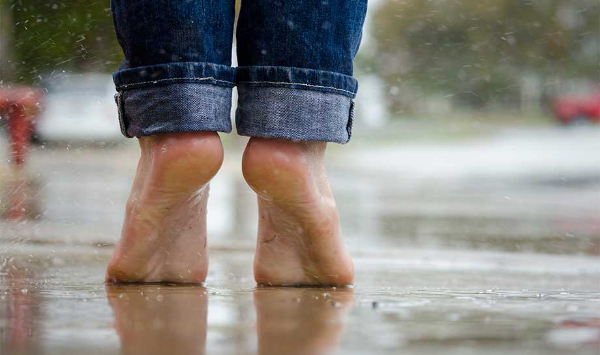Corns and calluses on the feet are common problems, but they cause a lot of discomfort for patients. In addition to the aesthetic issue, corns can also cause pain and discomfort.
It is possible to remove the calluses through different methods. Some examples are warm baths followed by exfoliation with pumice stone, calicides, products with exfoliating action indicated to remove calluses, which contain Salicylic Acid, Lactic Acid or Urea in their composition.
However, it is no use removing corns and calluses without treating the source of the problem. Therefore, it is essential that you read this text to the end and better understand why these problems are happening.
Corns are nothing more than your body's defense response. Due to constant friction in some areas of the foot, the skin becomes thicker as a kind of protection.
In this article, we'll talk more about corns and calluses, especially how you can treat this problem.
If you:
- You have corns and calluses on your feet or know someone who does;
- Feels pain in the feet and in areas with calluses...
This article is for you! Keep reading to learn about the subject and ask your questions about the treatments available:
What are corns and calluses and why do they appear?
Corns are your body's response to the “aggression” that the skin on your feet suffers daily. That is, anyone can develop calluses on their feet.
Many people confuse corns with "fish-eye" or warts. Let's start by clarifying this question better: calluses are very different from these other problems.
While calluses are a defense reaction to the friction your foot experiences daily, warts (fisheye) are caused by a virus that settles on the skin.
Calluses can appear for several reasons. There are internal and external factors that put your feet under stress, causing the problem. Let's understand better:
Calluses due to an acquired cause, that is, caused by external factors, are those that appear due to the use of new or inappropriate shoes. Some common villains are iron-toed boots and sharp-toed shoes.
Another factor that commonly leads to the formation of corns is problems with walking, such as crooked footsteps.
The internal causes, on the other hand, are usually generated by health problems such as arthrosis, osteoporosis, spinal problems, which can cause problems with gait, crooked footsteps.
An example of this is arthrosis, which modifies the structure of the fingers and takes the normal alignment out of walking.
Joint problems can also be a factor in the appearance of corns. They will usually be the ones that appear on top of the feet, known as a cushion.
In these cases, choosing the right shoe is essential, as shoes are structures that can be used to improve body alignment problems, crooked footsteps or gait problems.
Are corns different from calluses?
Yes. Corns are small dots, usually circular and regular, that appear on the feet. Calluses affect a larger area.
image
That is, calluses are like thicker skin patches that can cover large areas of the feet.
What are the types of corns?
All corns are developed due to some form of stress or friction on the feet. But as there are numerous possible causes for these aggressions, the types of calluses are varied. We can classify calluses and calluses into three main types:
- Plantar Corns;
- Dorsal Corns;
- Interdigital corns.
Next, let's learn more about each of them:
Plantar calluses
Plantar calluses, as the name suggests, appear on the soles of the feet. They have a very characteristic ring of keratosis around them. They can be painful or just cause some discomfort for the patient.
image
The good news is that they are easy to remove. Furthermore, they do not usually reappear, as long as the stressor is removed as well.
For example, if the podiatrist identifies that the cause of the callus was the use of inappropriate footwear, that pair should be retired.
Calluses are also common on the soles of the feet and can also be caused by gait problems.
Dorsal corns
Dorsal calluses are located on the top of the foot. They tend to hurt and bother a lot, as they interfere with putting on shoes and walking.
image
Dorsal calluses may have a ring of keratosis (being thicker), as they may be of the "cushion" type. This second one can leave a permanent mark on the feet, as there are no procedures for aesthetic intervention yet.
Despite this, both types of dorsal calluses can - and should - be treated by your podiatrist.
Interdigital corns
Interdigital calluses appear due to friction between the toes. They usually have a core (thick, keratinized, hard and yellowish area) and are extremely painful. This is because this nucleus is deep, making contact with an area full of nerve endings.
image
Luckily, there are treatments for this type of callus.
Attention: due to the great discomfort they cause, interdigital calluses are the ones that most patients try to remove at home. This, however, only makes the situation worse, potentially causing infections and countless other problems.
Therefore, always consult a podiatrist and do not remove corns or calluses at home, especially using sharp objects.
What is the treatment for corns and calluses?
Even though there are different types of corns and calluses, the treatments are very similar or, for the most part, the same. The process has three steps:
- Remove calluses or calluses;
- Uncore (if there is one);
- Remove the stressor.
As you can imagine, without identifying and removing the stressor (the reason for the appearance of the callus), there is no point in removing it. The corns or calluses will continue to appear.
Aggressively sanding corns and calluses using coarse sandpaper is not recommended. This can cause the rebound effect. That is, the body understands that it is more of an aggression and will create even more calluses and calluses.
It is also common to find people who have the habit of cutting the callus with sharp objects such as razors, cuticle pliers or scissors. This is inadvisable. In addition to an even more intense aggression, you still run the risk of causing cuts and sores that can inflame.
When removal with pumice stone after a warm bath is not enough, it is recommended to consult a podiatrist. This professional will assess the situation and extract the callus or callus.
The products indicated to remove corns are really efficient. However, you should keep in mind that they usually contain acid in their composition. Therefore, it is not recommended to use them at home. The ideal is for a podiatrist to guide you on the best product and perform the entire procedure in the office.
These medications work by breaking through the thick skin layers and moisturizing the dry, rough skin in these areas, which facilitates removal.
The novelty in offices is the use of PodoSafe. It is an instant, acid-free callus emollient that gently treats and minimizes calluses and calluses. Eliminating or reducing the need to use sharp piercing materials. Watch the video.
The best remedy, in all cases, is still prevention: removing the cause of the problem and always moisturizing your feet.
That is why it is essential to carry out a complete assessment with a podiatrist. This professional is prepared to do much more than sanding the calluses and removing the cores: he will help you understand and eliminate this problem for real!
Treatment for finger deformities: does it work?
Each patient is different, and it is important to make an individual assessment. After all, the triggers for the appearance of this problem are extremely varied. Often, finger deformities are precisely what is causing the friction.
However, in general, we can say that the treatment does work!
Make an appointment today so we can determine the best treatment for you.
Corns and calluses: you don't need to live with the pain
It is common to find patients who believe that corns or calluses are hopeless. It's true that when you take them out, they keep coming back.
However, this only happens because the treatment is not being complete: it is necessary to identify the cause of the formation of calluses and correct it.
So, make an appointment with us! And if you know someone who suffers from corns and calluses, please share this article. Corns and calluses are treatable, and you don't need to “learn to live with the pain”.






